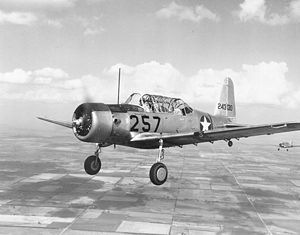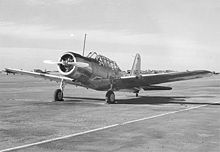Vultee BT-13 Valiant Video - N56882
|
|
Vultee BT-13 Valiant
BT-13 Valiant

Picture - BT-13 Valiant in flight
Role: Trainer
Manufacturer: Vultee
Designed by: Richard Palmer
First flight: March 1939
Primary users: United States Army Air Forces
United States Navy
The Vultee BT-13 Valiant was an American World War II-era basic trainer aircraft built by Vultee Aircraft for the United States Army Air Corps, and later US Army Air Forces. A subsequent variant of the BT-13 in USAAC/USAAF service was known as the BT-15 Valiant, while an identical version for the US Navy was known as the SNV and was used to train naval aviators for the US Navy, US Marine Corps and US Coast Guard.
Design and development
The Vultee BT-13 was the basic trainer flown by most American pilots during World War II. It was the second phase of the three phase training program for pilots. After primary training, the student pilot moved to the more complex Vultee for basic flight training. The BT-13 had a more powerful engine and was faster and heavier than the primary trainer. It required the student pilot to use two way radio communications with the ground and to operate landing flaps and a two-position Hamilton Standard variable pitch propeller. It did not, however, have retractable landing gear nor a hydraulic system. The large flaps are operated by a crank-and-cable system. Its pilots nicknamed it the "Vultee Vibrator."
Due to the demand for this aircraft, and others which used the same Pratt & Whitney engine, some were equipped with Wright powerplants of similar size and power built in 1941-42. The Wright-equipped aircraft were designated BT-15.
The Navy adopted the P&W powered aircraft as their main basic trainer, designating it the SNV. The BT-13 production run outnumbered all other Basic Trainer (BT) types produced.
It was back in 1938 that Vultee Aircraft's chief designer, Richard Palmer, began the design of a fighter. At this time the USAAC issued a requirement and design contest for an advanced trainer for which substantial orders had been promised to the victor. Palmer began to adapt his design concept from a fighter to that of an advanced trainer and the result of this was the V-51 prototype.

Picture - Vultee BT-13 on runway at Minter Field, California, 1 March 1943.
The aircraft made its maiden flight sometime during March 1939 as a cantilever low-wing monoplane of all-metal construction. Despite the use of metal throughout the design the control surfaces remained fabric-covered. The prototype was powered by a Pratt & Whitney R-1340-S3H1-G Wasp radial rated at 600 hp (447 kW) driving a two-blade variable pitch metal propeller. Other features included an enclosed cockpit for the crew of two, integral fuel tanks in the wings, and a hydraulic system for the operation of the flaps and retractable main landing gear.
The V-51 was entered into the USAAC competition as the BC-51 during May 1939. The USAAC instead chose the North American BC-2, but purchased the BC-51 prototype anyway, designating it the BC-3. Despite the disappointment, Palmer was not finished yet. He continued to refine the design of the VF-51 into the VF-54 in an attempt to meet the expectation of an export market for just such a trainer. The VF-54 used the same basic airframe as the VF-51, but was fitted with a lower powered engine. No export sales were made.
From this design, evolved the VF-54A. Instead of retractable gear, it had fixed gear very nicely faired and a revised power plant of a Pratt & Whitney R-985-T3B Wasp Jr. radial rated at 450 hp (335.5 kW) and the Vultee BT-13 Valiant was born.
The USAAC was made aware of the improvements made to the aircraft and in August 1939 the type was ordered as the BT-13. The initial order was for 300 aircraft with a Pratt & Whitney R-985-25 radial and the first of these was accepted by the USAAC in June 1940.
The BT-13A was produced to the extent of 7,037 aircraft and differed only in the use of a Pratt & Whitney R-985-AN-1 radial engine and lack of landing gear fairings. There were 1,125 BT-13B's produced and differed from the A model in having a 24-volt, rather than the original 12-volt electrical system.
The next variant was actually designated BT-15 because Pratt & Whitney found it impossible to keep up production of the R-985 engine. Instead a Wright R-975-11 radial was substituted into the 1,263 aircraft produced.
The US Navy began to show an interest in the aircraft as well and ordered 1,150 BT-13A models as the SNV-1. In addition, the Navy ordered some 650 aircraft designated as SNV-2, roughly equivalent to the BT-13B.
Once in service, the aircraft quickly got its nickname of "Vibrator" because it had a tendency to shake quite violently as it approached its stall speed. The BT-13 served its intended purpose well. It and its successors were unforgiving aircraft to fly, but were also extremely agile. Thus the BT-13 made a good aircraft to help transition many hundreds of pilots toward their advance trainers and fighters yet to be mastered.
After WWII, virtually all were sold as surplus for a few hundred dollars each. Many were purchased just to obtain their engines, which were mounted on surplus biplanes (such as Stearmans) to replace their less powerful engines for use as cropdusters. The BT airframes were then scrapped. Today, some "BT's" (collectively, BT-13s, BT-15s and SNVs) are still flying, though in very limited numbers (and none in military or government service).
Variants
BC-3
Vultee Model V.51 with retractable landing gear and a 600hp P&W R-1340-45, one built, not developed.
BT-13
Vultee Model V.54 with fixed undercarriage and a 450hp P&W R-985-25 engine, 300 built.
BT-13A
As BT-13 but fitted with a 450hp R-985-AN-1 engine and minor changes, 6407 built, survivors re-designated T-13A in 1948.
BT-13B
As BT-13A but with a 24-volt electrical system, 1125 built.
BT-15
As BT-13A with a 450hp Wright R-975-11 engine, 1693 built.
BT-16
One BT-13 was re-built in 1942 by Vidal with an all-plastic fuselage as the XBT-16.
SNV-1
BT-13As for the United States Navy, 1350 transferred from USAAF.
SNV-2
BT-13Bs for the United States Navy, 650 transferred from USAAF.
T-13A
Surviving BT-13As were re-designated in 1948, due to dual allocation of T-13 with the PT-13 in practice they were still known as the BT-13 to avoid confusion.
Popular culture

Picture - Tora Tora Tora BT-13 "Val" at The Wings Over Houston Airshow October 2007
One notable post-war "variant" of the BT's are the "Tora" aircraft. In the 1960s Twentieth Century Fox purchased many BT's and modified them (in some cases heavily) to appear similar to Japanese aircraft for use in the motion picture "Tora Tora Tora". The "Kate" torpedo bombers and "Val" dive bombers seen in this film are actually BT's (the "Zero" fighters are AT-6's). After the film, these aircraft were sold to private owners. Many are still flying, several of them as part of the Commemorative Air Force's "Tora Tora Tora" squadron, which performs air battle reenactments at air shows. Several "Tora" aircraft also appeared in the later "Pearl Harbor" film.
Specifications (BT-13)
General characteristics
Crew: two, student and instructor
Length: 28 ft 10 in (8.79 m)
Wingspan: 42 ft 0 in (12.80 m)
Height: 11 ft 6 in (3.51 m)
Wing area: 239 ft² (22 m²)
Airfoil: root: NACA 0018-64 mod; tip: NACA0009-64 mod (symmetrical)
Empty: 3,375 lb (1,531 kg)
Maximum takeoff: 4,496 lb (2,039 kg)
Powerplant: 1 x Pratt & Whitney R-985-AN-1, 450 hp (336 kW)
Performance
Maximum speed: 180 mph (290 km/h)
Range: 725 miles (1,167 km)
Service ceiling: 21,650 ft (6,600 m)
Museum displays
Mid-Atlantic Air Museum, Reading, Pennsylvania - 1942 BT-13A Valiant
Castle Air Museum, Atwater, California
Kalamazoo Air Zoo, Kalamazoo, Michigan
Combat Air Museum, Topeka, Kansas
Estrella WarBirds Museum, Paso Robles, California
Vultee BT-13 Valiant Pictures
Living Warbirds: The best warbirds DVD series.
Source: WikiPedia